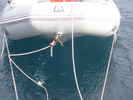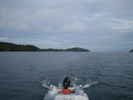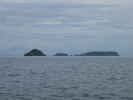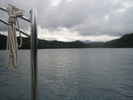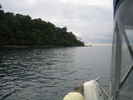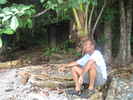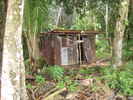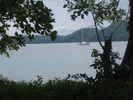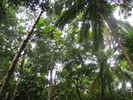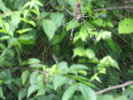28 nm from Islas Secas to 3 nights at Ensenada MuertosFrom Isla Cavada, we decided to head over to a place called Ensenada Muertos, about 29 nm away on the mainland. As we got RHAPSODY ready to go and I went forward to raise the anchor, I was surprised to find a small snake had made its way aboard and was resting on the anchor roller. I pushed him off with a boat hook. A few miles later I was surprised to see that he had found the painter (tow rope) for the dinghy and had climbed up it and was still riding along with us. A few shakes of the rope and our visitor hopped off and the last we saw him he was swimming along back to Isla Cavada. WAHOO had left Cavada a day earlier and had gone over to Isla Brincanco, in the Coiba National Park, and had reported to us on the radio that they were approached by a park ranger and told that they had to go to Isla Coiba to check in and pay to stay in the park. Once they got to Coiba they found out that they had to pay a one time fee of $20 per person and a daily fee of $30 for their boat. They checked for us and found out that we would have to bay $60 per day for our boat (which is bigger), so visiting Brincanco/Coiba would cost us a whopping $100 for the first day and $60 a day thereafter. Our original plan had been to follow WAHOO to Brincanco and Coiba, but after finding out the cost, along with the fact that there is no fishing allowed, we decided instead to head over to the mainland, which we did. When we pulled into the bahia at Ensenada Muertos we found it to be absolutely lovely, so we think we made the right decision. It took us 3 tries to get the hook down in a good place, as the bottom is all mostly hard rock & coral, but after we were down, we quite enjoyed the quiet place, spending three nights, seeing only a few huts, and hearing howler monkeys. On the first day, we swam from the boat to a reef near the shore and did some snorkeling. We didn't take any pictures but the snorkeling was quite good with even better visibility than we had found at Cavada. There were tons of large Parrotfish swimming around, as well as schools of many of the "usual" fish we have become familiar with: Sergeant Majors, Angel Fish, Tiger Fish, and so on. The second day we took our trash to shore and burned it. In these primitive locales, accumulating trash on the boat becomes somewhat of a problem, as there are no landfills or trash cans around. If we did give it to a local, they might very well just throw it on the side of the road. So we separate out all the glass, aluminum, steel cans, and organic matter and take the rest, paper and plastic mostly, and burn it. We break the glass and dump it overboard (where it becomes "sea glass") and we save the aluminum and steel cans for later (when we eventually get to a city). After making a nice hot fire from driftwood, we quickly disposed of our stuff. While we were burning our trash, we also policed the beach and gathered and burned a fairly large collection of stray plastic bottles, styrofoam, and other debris that we found. On our third morning at Ensenada Muertos, we were surprised when two other sailboats, SPIRIT, with Dan and Erin aboard, and PIPE DREAM, with Tim aboard, showed up. We went over and chatted with them and found out that they had been to all of the same places we had been and that we had several cruising-boat friends in common. |



